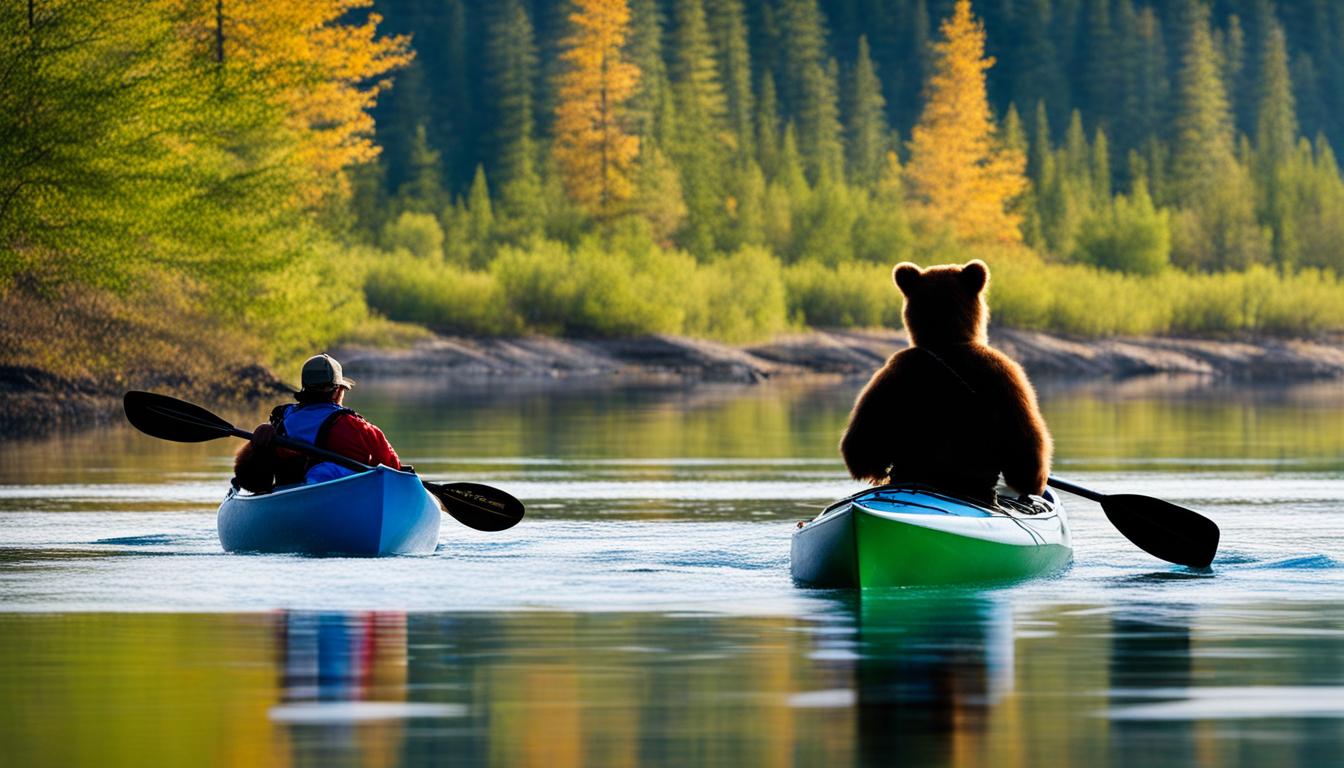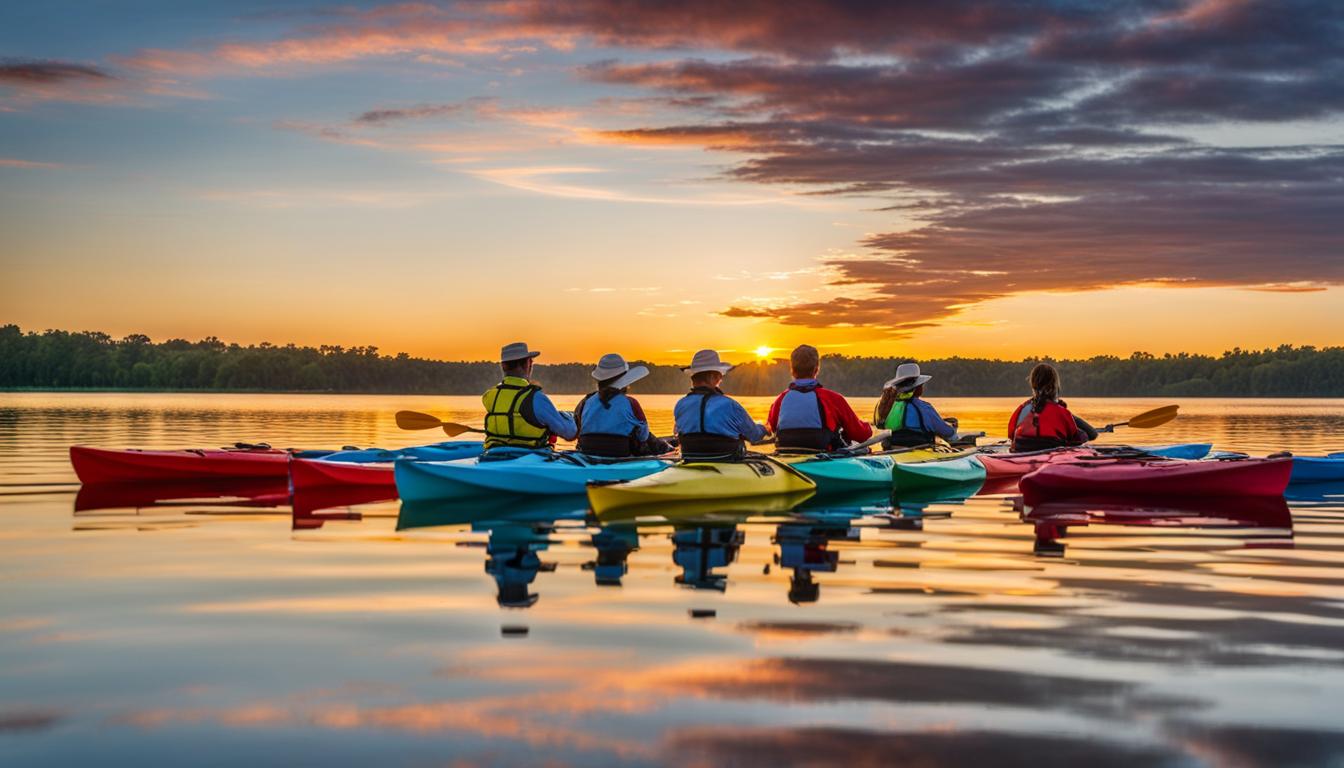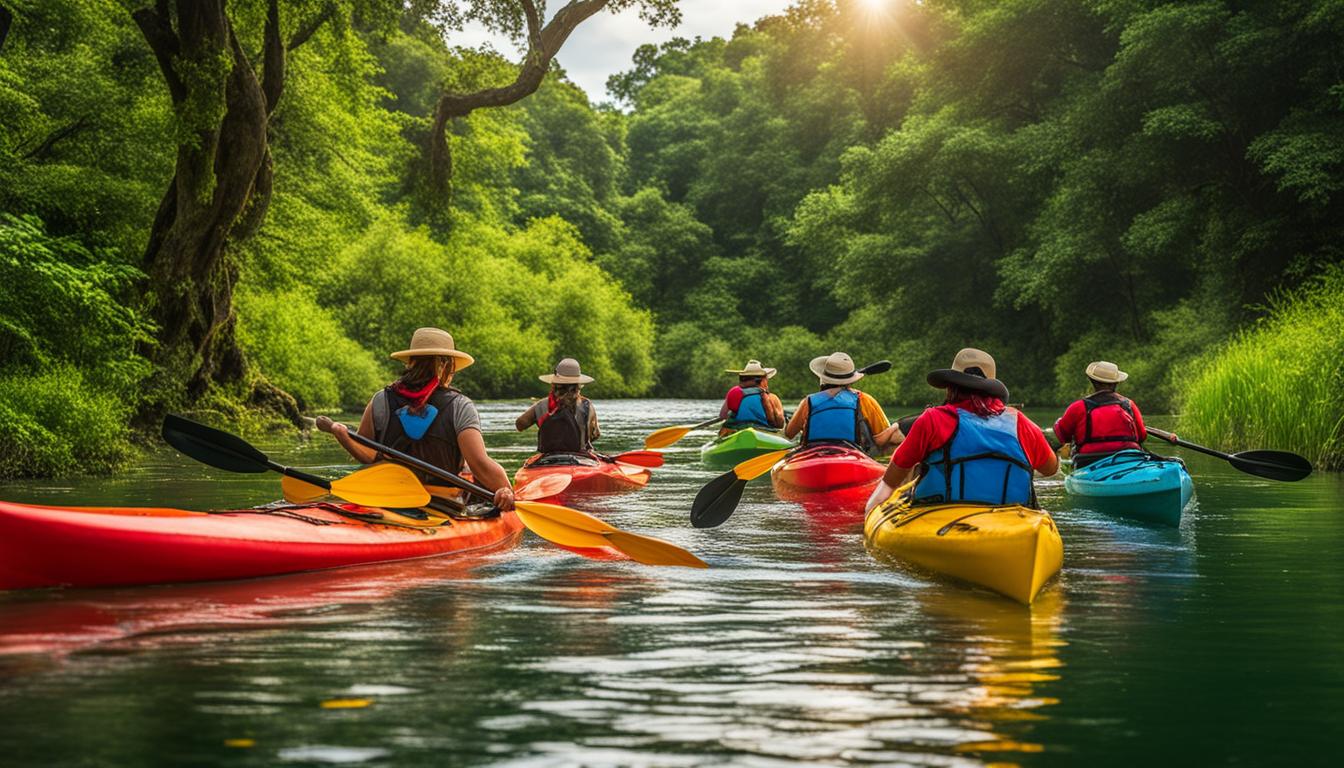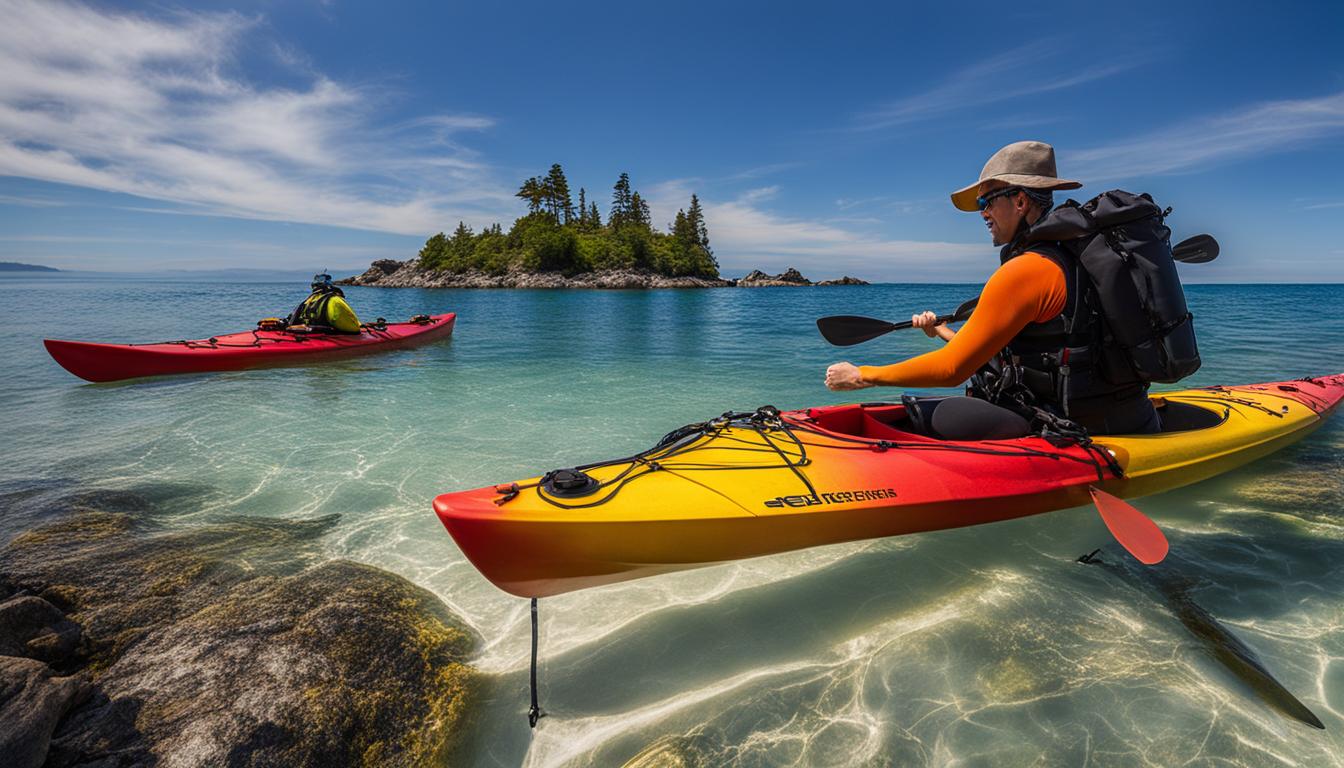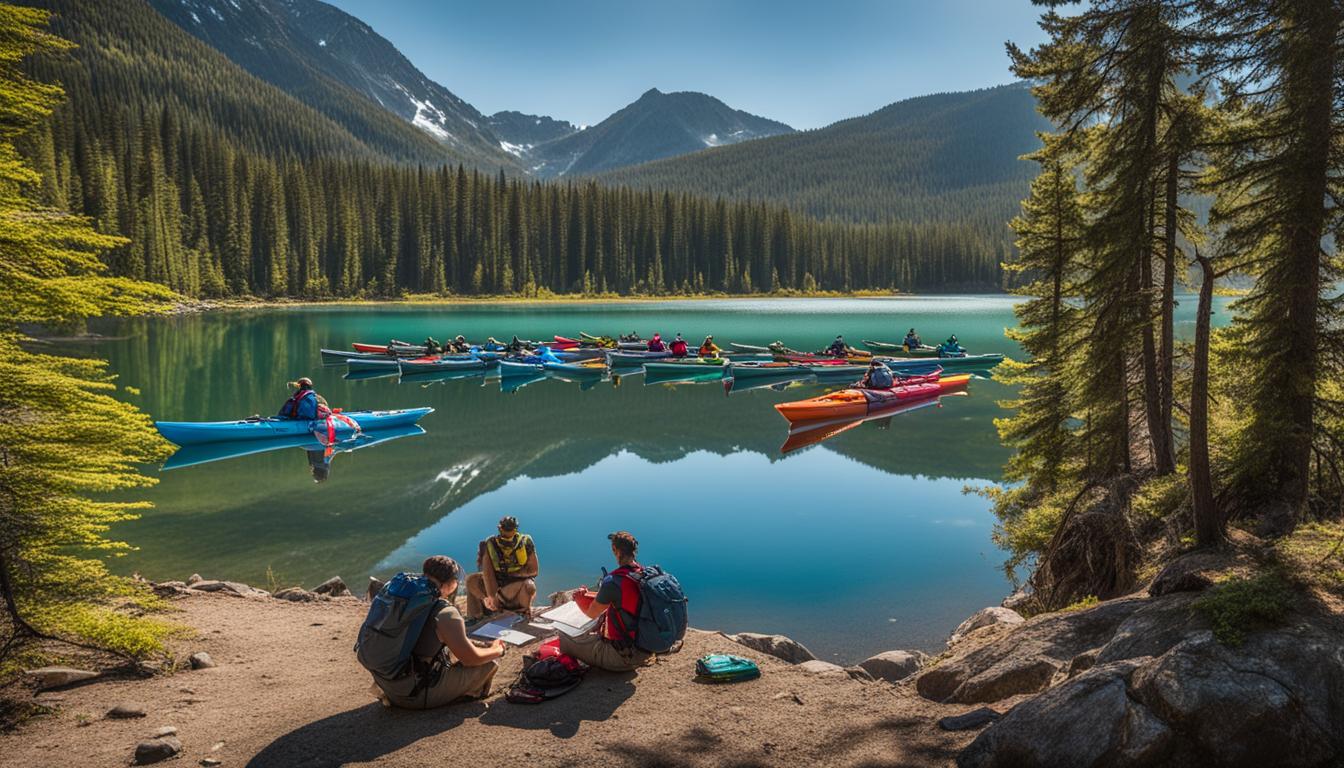When embarking on a kayak camping adventure, encountering wildlife is an exciting part of the experience. However, it’s crucial to prioritize safety and respect for both yourself and the animals you encounter. From maintaining a safe distance to understanding normal behaviors, responsible wildlife viewing practices are key to ensuring a memorable and harmonious trip. In this article, we will provide you with essential tips to handle wildlife encounters while kayak camping and highlight the importance of pre-trip research and education.
Key Takeaways:
- Research the wildlife in the area before your kayak camping trip.
- Keep a safe distance from wildlife to avoid disturbances and potential risks.
- Adhere to guidelines established by organizations like the National Parks Service.
- Respect wildlife and their habitat by observing from a distance and avoiding actions that may attract them.
- Conduct pre-trip research to understand normal behaviors and learn about local guidelines and closure schedules.
Tips for Safe Wildlife Encounters in Kayak Camping
When embarking on a kayak camping adventure in wildlife areas, it’s crucial to take necessary precautions to ensure safe wildlife encounters. By following these tips, you can coexist with wildlife while enjoying your kayaking experience.
Respect Wildlife from a Distance
One of the most important rules when encountering wildlife is to maintain a safe distance. This not only protects you but also avoids disturbing the animals. Research the wildlife species in the area before your trip to familiarize yourself with their behaviors and create awareness.
“Maintaining a respectful distance from wildlife is essential to their well-being and your safety,” says wildlife expert, Dr. Jane Davis. “By observing from afar, you can appreciate their beauty without causing harm.”
Properly Store Food and Trash
Wildlife can be attracted to food and trash, so it’s important to store them properly. Use bear-proof containers or hang them from trees away from your campsite. By minimizing food odors, you can significantly reduce the chances of unwanted animal encounters.
Carry Essential Safety Gear
While encountering wildlife, it’s always a good idea to be prepared. Carry essential gear, such as snake boots, insect repellent, and bear spray, depending on the wildlife prevalent in the area. These items can provide an added layer of safety and peace of mind during your kayak camping trip.
| Tips for Safe Wildlife Encounters | |
|---|---|
| Respect Wildlife from a Distance | Observe wildlife from a safe distance to prevent disturbance. |
| Properly Store Food and Trash | Use bear-proof containers and keep your campsite clean to avoid attracting animals. |
| Carry Essential Safety Gear | Equip yourself with snake boots, insect repellent, and bear spray for added safety. |
Respecting Wildlife and Protecting their Habitat
When you embark on a kayak camping adventure, respecting wildlife and their habitat is paramount. By adhering to responsible practices, you can minimize your impact on the natural environment and ensure the well-being of the animals you encounter.
Observe from a Distance
One of the most important aspects of respecting wildlife during kayak trips is to observe them from a safe distance. Keep in mind that animals need their space and can become stressed or defensive if approached too closely. Use binoculars or a zoom lens to get a closer look without encroaching on their territory.
Avoid Disturbances
To respect wildlife and their habitat, it’s crucial to avoid any actions that may disturb them. This means refraining from making loud noises, sudden movements, or using items like drone cameras that may startle or disrupt their natural behaviors. By being mindful of your actions, you can ensure the animals feel safe and undisturbed in their environment.
Maintain Clean Campsites
Another important aspect of respecting wildlife is to keep your campsite clean and free of waste. Properly dispose of all trash and food remnants in designated containers, as this will help prevent animals from becoming attracted to your campsite. By minimizing food odors and reducing the risk of wildlife scavenging, you not only protect the animals from potentially harmful encounters but also maintain the integrity of their natural habitat.

| Wildlife Encountered | Approach and Behavior | Recommended Action |
|---|---|---|
| Bears | Claws ground, huffs, or growls | Slowly back away, avoid eye contact |
| Deer | Freezes or runs away | Keep distance, do not chase |
| Moose | Displays aggressive behavior | Back away slowly, create distance |
| Seals | Alert, may vocalize or show curiosity | Observe from the water, avoid approaching on land |
By respecting wildlife and protecting their habitat, you contribute to the preservation of natural ecosystems and create a harmonious coexistence with nature during your kayak camping trips.
The Importance of Pre-Trip Research and Education
When planning a kayak camping trip, it is crucial to conduct thorough pre-trip research and educate yourself about the local wildlife habitat, in order to ensure a safe and enjoyable experience. By understanding the normal behaviors of the wildlife in the area, you can avoid unintentional disturbances and minimize your impact on their natural habitat. Additionally, familiarizing yourself with the local guidelines and closure schedules provided by organizations such as the National Parks Service will help you navigate the area responsibly.
Pre-trip research allows you to identify potentially dangerous wildlife species that you may encounter during your camping trip. Armed with this knowledge, you can take necessary precautions to coexist peacefully with the wildlife, ensuring the safety of both yourself and the animals. Understanding the normal behaviors of the wildlife will enable you to recognize signs of disturbance and modify your actions accordingly, allowing for a respectful wildlife experience.
| Research Areas | Information |
|---|---|
| Wildlife Species | Identify potentially dangerous species and their behaviors |
| Local Guidelines | Review regulations and closure schedules |
| Normal Behaviors | Recognize signs of disturbance and adjust actions |
Remember, the goal of your kayak camping trip should be to enjoy the beauty of nature while minimizing your impact on the wildlife habitat. Responsible camping practices start with pre-trip research and education, ensuring that you are well-prepared to coexist harmoniously with the wildlife you encounter. By taking the time to gather information, you can make informed decisions and contribute to the conservation efforts aimed at protecting these fragile ecosystems.
Key Takeaways:
- Conduct thorough pre-trip research to educate yourself about the local wildlife habitat.
- Understand the normal behaviors of the wildlife to avoid disturbances.
- Review the local guidelines and closure schedules to navigate responsibly.
- Identify potentially dangerous wildlife species and take necessary precautions.
- Recognize signs of disturbance and adjust your actions accordingly.
Expert Insights on Wildlife Safety in Kayak Camping
When it comes to wildlife safety in kayak camping, it’s important to follow the advice and insights of experts. These professionals stress the significance of responsible wildlife viewing practices and the need for proper management of wildlife encounters during kayak trips.
One key aspect highlighted by experts is the importance of conducting pre-trip research. This includes researching the wildlife species in the area you plan to kayak camp and learning about their behaviors. By understanding normal behaviors, you can recognize signs of disturbance and adjust your approach accordingly, ensuring a safer and more enjoyable experience.
Experts also emphasize the need to adhere to local guidelines and regulations. These guidelines are often established to protect both campers and wildlife. By respecting the set distance limits and following any closures or restrictions, you can minimize your impact on the animals and their habitats, promoting a harmonious coexistence between humans and wildlife.
“Responsible wildlife viewing practices, including researching the wildlife, learning about local guidelines, and keeping a safe distance, are key to ensuring a safe and enjoyable wildlife experience while minimizing our impact on the animals and their habitats.” – Wildlife Expert
By seeking advice from park rangers, tour guides, or experienced kayak campers, you can gather valuable insights and tips on managing wildlife encounters. These experts can provide firsthand knowledge about the specific challenges and precautions required for different wildlife species or habitats, allowing you to make informed decisions and prevent potential dangers during your kayak camping trips.
Responsible Wildlife Viewing Practices
To summarize the expert insights on wildlife safety in kayak camping, it’s crucial to practice responsible wildlife viewing. This involves:
- Researching the wildlife in the area
- Learning about local guidelines and regulations
- Keeping a safe distance from wildlife
By following these practices and seeking expert advice, you can ensure a safe and enjoyable wildlife experience while protecting the animals and their habitats.
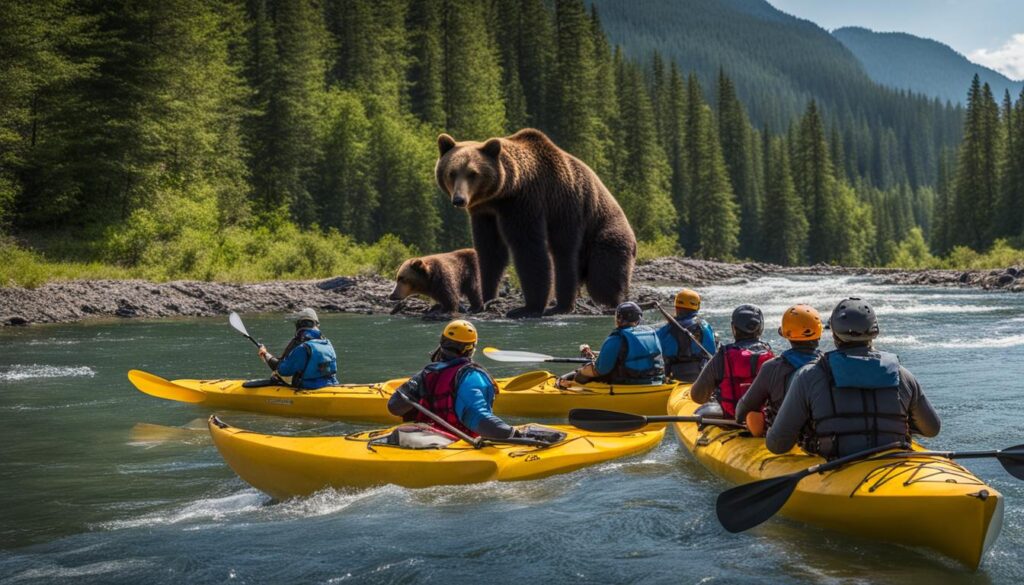
Mitigating Risks in Wildlife Encounters While Tent Camping
Tent camping in the wilderness can be an exhilarating experience, but it’s natural to have concerns about negative interactions with wildlife. While the chances of encountering animals are relatively low, it’s essential to take precautions to minimize camping risks and ensure a safe trip.
One of the most important measures is storing food and trash properly. Wildlife is attracted to the scent of food, and failure to secure it can lead to unwanted visits from animals. Utilizing bear-resistant containers or hanging food from trees can help keep wildlife at a safe distance. By doing so, you reduce the likelihood of an animal entering your campground in search of a meal.
“It is advisable to store all food and trash securely, at least 100 yards away from your tent. This prevents animals from becoming habituated to human presence and reduces the risk of attracting them to your campsite.”
Table: Common Wildlife and Camping Risks
| Wildlife | Potential Risk |
|---|---|
| Bears | Food theft, property damage, potential for aggression |
| Snakes | Possible venomous bites |
| Skunks | Nuisance, unpleasant odor |
| Raccoons | Food theft, property damage |
| Coyotes | Food theft, potential for aggression |
Learning about potentially dangerous wildlife species in the area is crucial for your safety. Understanding their habits, preferred habitats, and signs of aggression can help you avoid unnecessary risks. Additionally, keeping a safe distance from wildlife and appreciating them from afar is essential. Remember that wild animals are just that, wild, and should not be approached, fed, or interacted with in any way.
While some campers may consider carrying self-defense items, it is important to prioritize precautions and responsible camping practices. Being aware of your surroundings, respecting wildlife, and following the recommended guidelines will greatly reduce the likelihood of negative encounters and ensure a safe and enjoyable tent camping experience.
Conclusion
When it comes to wildlife encounters while kayak camping, your safety and the well-being of the animals should be a top priority. By practicing responsible camping practices and following a few simple guidelines, you can have a safe and enjoyable experience while coexisting harmoniously with wildlife.
Remember to conduct pre-trip research to familiarize yourself with the wildlife species in the area and understand their behaviors. This knowledge will help you avoid disturbances and minimize your impact on their natural habitats. Following local guidelines and closure schedules is crucial, as they are designed to protect both you and the wildlife.
Responsible camping practices include keeping a safe distance from wildlife, refraining from feeding them, and properly storing food and trash to prevent attracting animals to your campsite. Additionally, always respect their activities and avoid sensitive areas or nesting sites during critical times. By doing so, you can contribute to the conservation efforts and help preserve these fragile ecosystems for future generations.
So, as you embark on your next kayak camping adventure, remember the importance of camping safety and responsible practices. Enjoy the beauty of nature, observe wildlife from a safe distance, and create lasting memories while respecting the animals and their habitats. Happy camping!
FAQ
What should I do if I encounter wildlife while kayak camping?
It’s important to maintain a safe distance from wildlife and avoid approaching them. Do not feed them or attempt to catch them. Research the wildlife species in the area and follow local guidelines to ensure a safe encounter.
How can I prevent wildlife from being attracted to my campsite?
Properly store food and trash to prevent attracting wildlife. Avoid leaving out any food or waste that may attract animals. By keeping a clean campsite, you can minimize the chances of wildlife being drawn to your area.
Should I carry any self-defense items during kayak camping?
While some campers may choose to carry self-defense items, it’s important to prioritize precautions and responsible camping practices. Maintaining a safe distance, following guidelines, and avoiding disturbances are the most effective ways to have a safe and enjoyable wildlife experience.
How can I minimize my impact on wildlife and their habitats?
Avoid sensitive areas and respect buffer zones established around wildlife sites. Observe from a distance and avoid actions or noises that may disturb the animals. By keeping their habitats clean and free of waste, you contribute to their health and well-being.
How can I learn about the behaviors of wildlife species in the area?
Conduct pre-trip research and education to learn about the wildlife species in the area you plan to kayak camp. Understand their normal behaviors and nesting seasons to avoid disturbing them. Review local guidelines and closure schedules for additional information.
Are there any specific precautions I should take when kayak camping in bear country?
When camping in bear country, it’s important to wear appropriate gear like snake boots and carry pepper spray. Store food and trash in bear-resistant containers and follow guidelines for camping in bear habitats. Being prepared and knowledgeable about bear safety can help ensure a safe experience.
How can I contribute to wildlife conservation efforts during kayak camping?
By following responsible camping practices and respecting wildlife and their habitats, you can contribute to conservation efforts. Minimize your impact by adhering to guidelines, staying informed, and avoiding disturbances to the animals and their environment.
Can I bring my dog along for kayak camping trips?
If you decide to bring your dog, it’s important to keep them on a leash and under control at all times. Some areas may have restrictions on dogs, so research and follow the guidelines specific to the location you plan to kayak camp.

